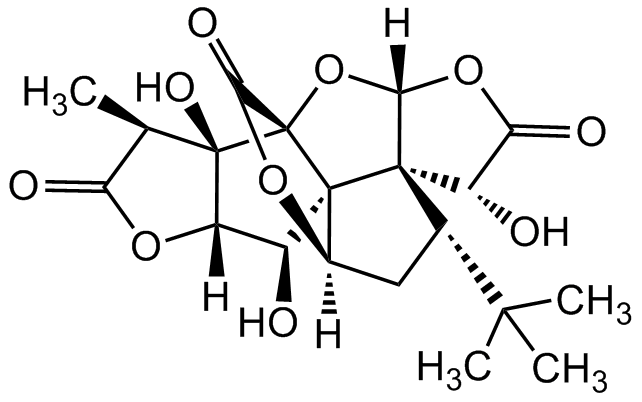Ginkgolide B
| Code | Size | Price |
|---|
| CDX-G0218-M010 | 10 mg | £48.00 |
Quantity:
| CDX-G0218-M050 | 50 mg | £139.00 |
Quantity:
Prices exclude any Taxes / VAT
Overview
Host Type: Plant
Regulatory Status: RUO
Shipping:
AMBIENT
Storage:
Short Term: +4°C, Long Term: -20°C
Images
Documents
Further Information
Alternate Names/Synonyms:
BN-52021
Appearance:
White powder.
CAS:
15291-77-7
EClass:
32160000
Form (Short):
liquid
Handling Advice:
Protect from light and moisture.
InChi:
InChI=1S/C20H24O10/c1-6-12(23)28-11-9(21)18-8-5-7(16(2,3)4)17(18)10(22)13(24)29-15(17)30-20(18,14(25)27-8)19(6,11)26/h6-11,15,21-22,26H,5H2,1-4H3/t6-,7+,8-,9+,10+,11+,15+,17+,18+,19-,20-/m1/s1
InChiKey:
SQOJOAFXDQDRGF-MMQTXUMRSA-N
Long Description:
Chemical. CAS: 15291-77-7. Formula: C20H24O10. MW: 424.40. Ginkgolide B, a terpenoid extracted from G. biloba leaves, is a potent PAFR antagonist that inhibits platelet aggregation. Platelet-activating factor (PAF) is an important mediator of cell proliferation, angiogenesis, inflammatory response regulation, vasodilation, superoxide formation and platelet aggregation. These cellular effects are mediated through its specific G-protein coupled receptor, PAFR. Ginkgolide B has been shown to have anticancer properties by inducing apoptosis and blocking the cell cycle. Ginkgolide B also demonstrates number of other anti-inflammatory, anti-allergic, antioxidant and neuroprotective effects.
MDL:
MFCD05662347
Molecular Formula:
C20H24O10
Molecular Weight:
424.4
Package Type:
Vial
Product Description:
Ginkgolide B, a terpenoid extracted from G. biloba leaves, is a potent PAFR antagonist that inhibits platelet aggregation. Platelet-activating factor (PAF) is an important mediator of cell proliferation, angiogenesis, inflammatory response regulation, vasodilation, superoxide formation and platelet aggregation. These cellular effects are mediated through its specific G-protein coupled receptor, PAFR. Ginkgolide B has been shown to have anticancer properties by inducing apoptosis and blocking the cell cycle. Ginkgolide B also demonstrates number of other anti-inflammatory, anti-allergic, antioxidant and neuroprotective effects.
Purity:
>98% (HPLC)
SMILES:
O=C1[C@@H](C)[C@]([C@](O1)([H])[C@@H]2O)(O)[C@]([C@]32[C@@]4([H])C[C@@H](C(C)(C)C)[C@]53[C@H]6O)(C(O4)=O)O[C@]5([H])OC6=O
Solubility Chemicals:
Soluble in DMSO (30mg/ml) or ethanol (10mg/ml).
Source / Host:
Plant
Transportation:
Non-hazardous
UNSPSC Category:
Natural Products/Extracts
UNSPSC Number:
12352200
Use & Stability:
Stable for at least 2 years after receipt when stored at -20°C.
References
(1) E. Foldes-Filep, et al.; BBRC 148, 1412 (1987) | (2) K. Funkunaga, et al.; J. Biol. Chem. 276, 43025 (2001) | (3) K.M. Maclennan, et al.; Prog. Neurobiol. 67, 235 (2002) | (4) E.L. Kondratskaya, et al.; Brain Res. Bull. 63, 309 (2004) | (5) X. Shi-hai & F. Dian-chun; Chin. Med. J. 120, 922 (2007) | (6) H.J. Cho & K.S. Nam; J. Biochem. Mol. Biol. 40, 678 (2007) | (7) M. Aponte, et al.; Cancer Res. 68, 5839 (2008) | (8) Y.D. Hsuuw, et al.; Ann. N Y Acad. Sci. 1171, 501 (2009) | (9) S. Zhang, et al.; J. Cardiovasc. Pharmacol. 57, 721 (2011) | (10) C. Zhang, et al.; Toxicology 287, 124 (2011) | (11) X. Chu, et al.; Molecules 16, 7634 (2011) | (12) W. Jiang, et al.; Integr. Cancer Ther. 13, NP10-7 (2012) | (13) J.H. Gu, et al.; Eur. J. Pharm. Sci. 47, 652 (2012)



